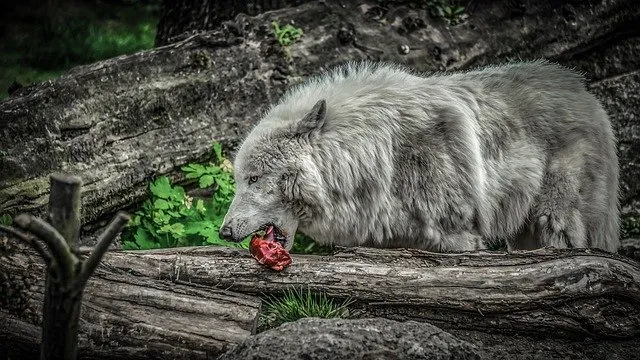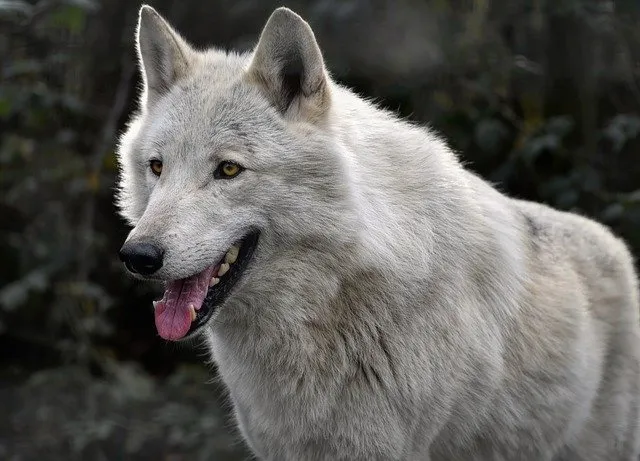As an Amazon Associate I earn from qualifying purchases.
The enigmatic gray wolf takes center stage in nature’s grand arena, where the curtains of wilderness reveal a symphony of many of life’s players. A creature that has long ignited curiosity and inspired awe, the gray wolf stands as a sentinel of the wild, a testament to the intricate tapestry of predator-prey relationships. At the heart of this enigma lies the question that echoes through the ages: “What do gray wolves eat?”
This query opens a portal into the culinary world of these majestic canids, inviting us to unravel the diverse menu that sustains their existence and shapes the ecosystems they call home. Join us as we embark on a captivating journey through the taste preferences of the gray wolf, uncovering the surprises and strategies that underscore their vital role in the tremendous ecological drama.
What Do Gray Wolves Eat?
In the heart of the wild, where the echo of primal howls resonates, the gray wolf prowls as a true embodiment of nature’s magnificence. A creature revered for its intelligence and hunting prowess, the gray wolf’s diet is a fascinating tapestry woven with intricacies and adaptations that have allowed it to thrive for centuries. Join us as we embark on a gastronomic journey through the dietary habits of these awe-inspiring predators, unveiling the secrets of what sustains their majestic existence.
1. Deer Delights: The Main Course of Choice
When discussing the gray wolf’s diet, it’s impossible to ignore their primary choice of prey: deer. The gray wolf is a skilled hunter with adaptations such as keen senses, sharp teeth, and strong jaws designed to take down ungulates like deer. Whether it’s white-tailed deer, mule deer, or even elk, these majestic creatures provide a vital source of sustenance for the wolf packs. The wolves‘ hunting strategies often involve teamwork and tactics to showcase their incredible social dynamics.
2. Bison Banquets: Taking on the Titans
The gray wolf’s diet expands to include these massive herbivores in regions where bison roam. Wolves have been known to target weaker or injured bison, demonstrating their ability to identify vulnerabilities within a herd. A bison hunt requires strength and cunning, and a remarkable understanding of the prey’s behavior and movements.
3. Small Wonders: From Hares to Rodents
While larger prey items dominate the gray wolf’s menu, smaller animals also play a crucial role in their diet. Rabbits, hares, and rodents like beavers and mice are opportunistically hunted when larger prey is scarce. This adaptability underscores the gray wolf’s ability to survive in diverse environments and maintain a balanced diet.
4. Berries and Greens: A Side of Vegetation
Contrary to popular belief, the gray wolf’s diet isn’t solely composed of meat. They occasionally consume plant matter like berries and grasses. This supplementary intake may aid digestion and provide essential nutrients, showcasing the wolf’s adaptability to varying conditions.
5. Scavenger’s Surprise: Nature’s Cleanup Crew
Gray wolves are not above scavenging and play a valuable role as nature’s cleanup crew. Feeding on carrion – the remains of animals that have already died – contributes to ecosystem health by preventing the spread of disease and minimizing waste. This scavenging behavior also demonstrates the gray wolf’s ecological importance beyond its role as a predator.
How Do Gray Wolves Hunt Their Prey?
Gray wolves are remarkable predators known for their strategic hunting techniques and cooperative behaviors. The success of their hunts is often attributed to their strong social structure within packs and their adaptability to different prey and landscapes. Here’s an overview of how gray wolves hunt their prey:
1. Teamwork and Cooperation:
Gray wolves are known for their incredible ability to work together as a coordinated team during hunts. They live in packs, typically with a dominant breeding pair (alpha male and female) and their offspring. When hunting, they utilize their numbers advantage to overpower larger prey and take down formidable animals like deer, elk, and bison.
2. Tracking and Stalking:
The hunt usually begins with the wolves using their keen senses of smell and hearing to locate potential prey. They can track animals over long distances, using their sensitive noses to detect scents left behind. Once they’ve located prey, they employ stealth and patience, slowly stalking their target to get as close as possible without alerting it.
3. Selecting Targets:
Wolves often target vulnerable individuals within a herd, such as young, old, or sick animals. This selection is a survival strategy, as it reduces the risk of injury to the wolves during the hunt. Wolves‘ ability to assess the condition of potential prey showcases their understanding of the ecosystem’s dynamics.
4. Coordination and Communication:
During the final moments of the hunt, the pack members communicate through body language, vocalizations, and eye contact to coordinate their attack. This coordination is vital to ensure that the prey cannot escape easily.
5. Chase and Takedown:
Once the wolves initiate the chase, they use their stamina and teamwork to pursue the prey. Wolves are not typically known for their speed, but they possess incredible endurance, allowing them to chase prey for extended distances. They may take turns pursuing the prey, utilizing their stamina effectively to exhaust it.
6. Surround and Subdue:
During the chase, the wolves attempt to surround the prey, cutting off escape routes. If the prey tries to change direction, other pack members are strategically positioned to intercept it. Once the prey is exhausted, the wolves bring it down by biting its hindquarters and pulling it to the ground.
7. Swift and Efficient Killing:
The final stage of the hunt involves delivering fatal bites to the prey’s throat or vital areas to ensure a quick and humane kill. This efficient method minimizes the prey’s suffering and reduces the risk of injury to the wolves.
8. Sharing the Bounty:
After successfully bringing down the prey, the pack members share in the feast. The dominant individuals often eat first, but they regurgitate food for the younger or less dominant members of the pack, reinforcing the strong social bonds that sustain the pack’s cohesion.
How Do Gray Wolves Help Our Ecosystem?
Gray wolves play a crucial role in maintaining the health and balance of the ecosystems they inhabit. Their presence has far-reaching effects that ripple through various species and environmental dynamics. Here’s how gray wolves contribute to ecosystem health:
1. Population Control:
Gray wolves help control the populations of prey species like deer, elk, and moose. By preying on weaker or sick individuals, they prevent the overpopulation of these herbivores, which can lead to overgrazing of vegetation and habitat degradation. This, in turn, benefits plant communities and other wildlife that rely on these habitats.
2. Trophic Cascade:
Wolves are a prime example of a “keystone species.” Their presence has a cascading effect throughout the ecosystem, known as a trophic cascade. When wolves control prey populations, it affects the behavior and movement of those prey species. For instance, decreased deer populations due to wolf predation can lead to less browsing on vegetation, allowing vegetation to recover and stabilize riverbanks and stream ecosystems.
3. Habitat Restoration:
As wolves indirectly influence the behavior of prey animals, they also impact their feeding habits. Reduced browsing pressure from deer and elk can lead to the recovery of plant species, which can be crucial for restoring native habitats. This habitat recovery, in turn, benefits a wide range of other plant and animal species that rely on healthy ecosystems.
4. Enhancing Biodiversity:
The presence of wolves helps maintain a diverse range of wildlife species. When the populations of herbivores are kept in check, it prevents one species from dominating and creating a monoculture. This supports the overall biodiversity of an ecosystem, promoting the health of various plant and animal species.
5. Carrion Consumption:
Wolves are also scavengers, consuming the remains of animals that have died from natural causes or other predators. This scavenging behavior helps to prevent the spread of diseases that can arise from carcasses left to rot. By consuming carrion, wolves act as nature’s cleanup crew, benefiting the ecosystem’s overall health.
6. Predator-Prey Balance:
Wolves maintain a balance between predators and prey. They can limit the populations of smaller predators like coyotes and foxes, which can positively affect the populations of smaller prey animals. This balance has a domino effect on the entire ecosystem, helping to maintain stability.
7. Ecosystem Resilience:
The presence of gray wolves contributes to ecosystem resilience by introducing natural checks and balances. This makes the ecosystem more adaptable to changes and disturbances, helping it withstand climate fluctuations and disease outbreaks better.
Final Words
In the grand tapestry of nature, gray wolves emerge as architects of balance and vitality within their ecosystems. Their prowess as hunters, social cohesion, and role as keystone species orchestrate a harmonious melody that resonates through every corner of the wild. From controlling prey populations to nurturing habitat recovery, the impact of gray wolves is woven into the very fabric of life. As we marvel at their intricate web of contributions, let us recognize that protecting these majestic creatures isn’t just an act of preservation but a commitment to upholding the delicate equilibrium that sustains our planet’s natural wonders.
You can also read
1.What Do Russian Tortoises Eat? A Guide to Their Nutritious Diet
2.What Do Red-Winged Blackbirds Eat? Exploring the Diverse Diet
3.What Do Red Squirrels Eat? Red Squirrels’ Culinary Adventures
4.What Do Purple Martins Eat? A Gourmet Guide to Their Diet
Amazon and the Amazon logo are trademarks of Amazon.com, Inc, or its affiliates.




